TOYOTA GT86 2016 Owners Manual (in English)
Manufacturer: TOYOTA, Model Year: 2016, Model line: GT86, Model: TOYOTA GT86 2016Pages: 464, PDF Size: 17.53 MB
Page 101 of 464
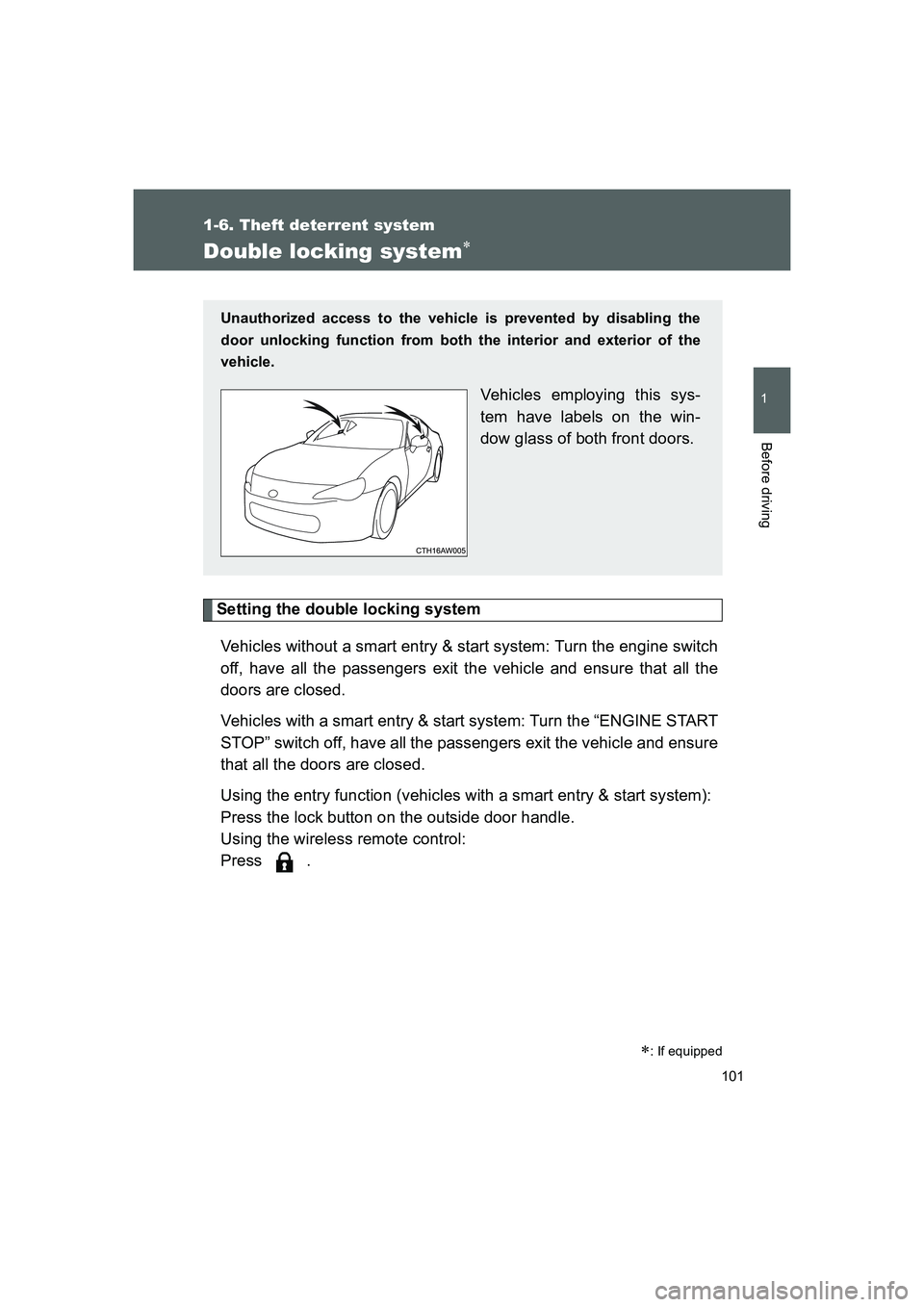
101
1
1-6. Theft deterrent system
Before driving
FT86_EE
Double locking system∗
Setting the double locking system
Vehicles without a smart entry & start system: Turn the engine switch
off, have all the passengers exit the vehicle and ensure that all the
doors are closed.
Vehicles with a smart entry & start system: Turn the “ENGINE START
STOP” switch off, have all the passengers exit the vehicle and ensure
that all the doors are closed.
Using the entry function (vehicles with a smart entry & start system):
Press the lock button on the outside door handle.
Using the wireless remote control:
Press .
∗: If equipped
Unauthorized access to the vehicle is prevented by disabling the
door unlocking function from both the interior and exterior of the
vehicle.
Vehicles employing this sys-
tem have labels on the win-
dow glass of both front doors.
86_OM_EE_OM18058E.book 101 ページ 2015年3月17日 火曜日 午前11時31分
Page 102 of 464
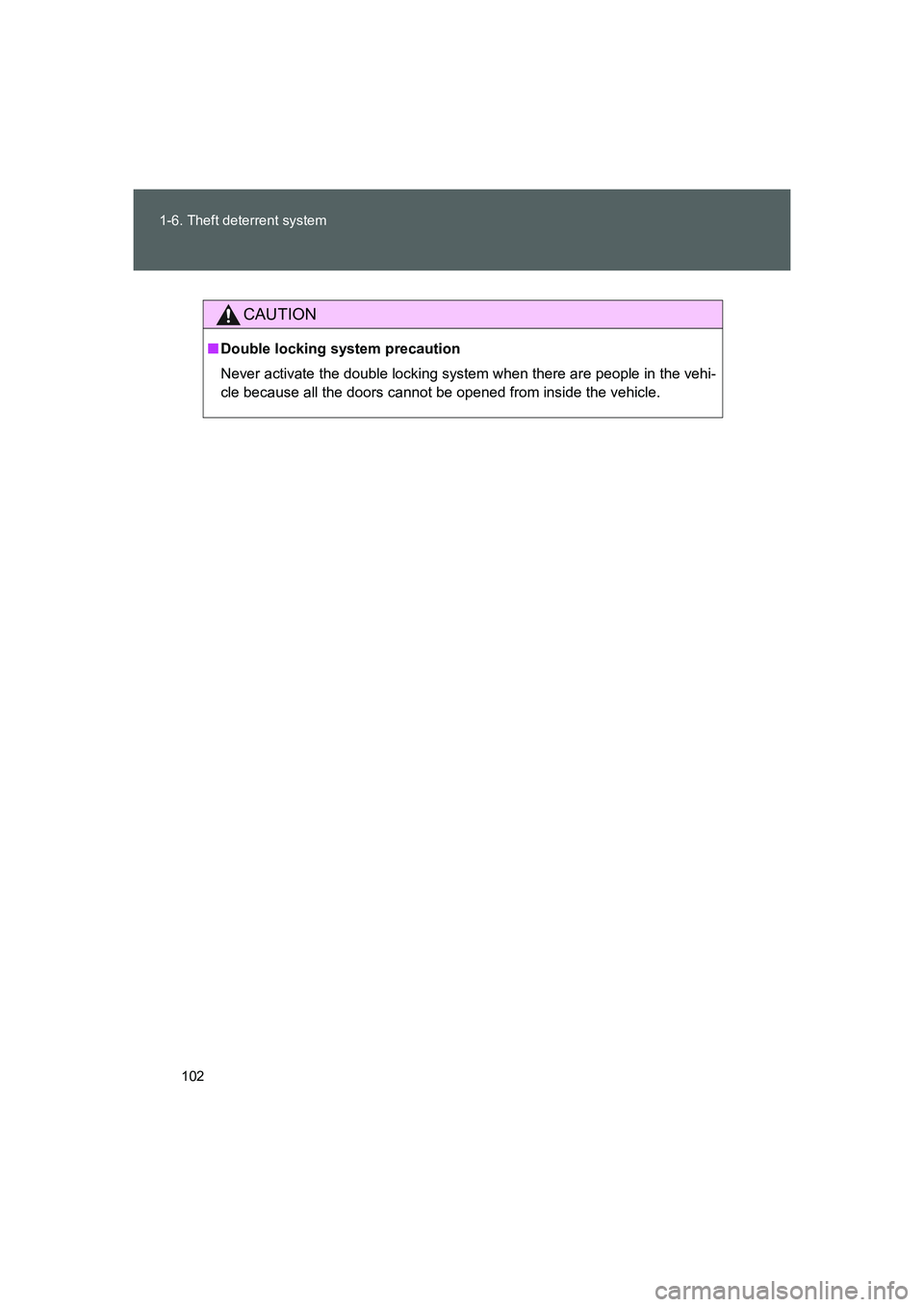
102 1-6. Theft deterrent system
FT86_EE
CAUTION
■Double locking system precaution
Never activate the double locking system when there are people in the vehi-
cle because all the doors cannot be opened from inside the vehicle.
86_OM_EE_OM18058E.book 102 ページ 2015年3月17日 火曜日 午前11時31分
Page 103 of 464
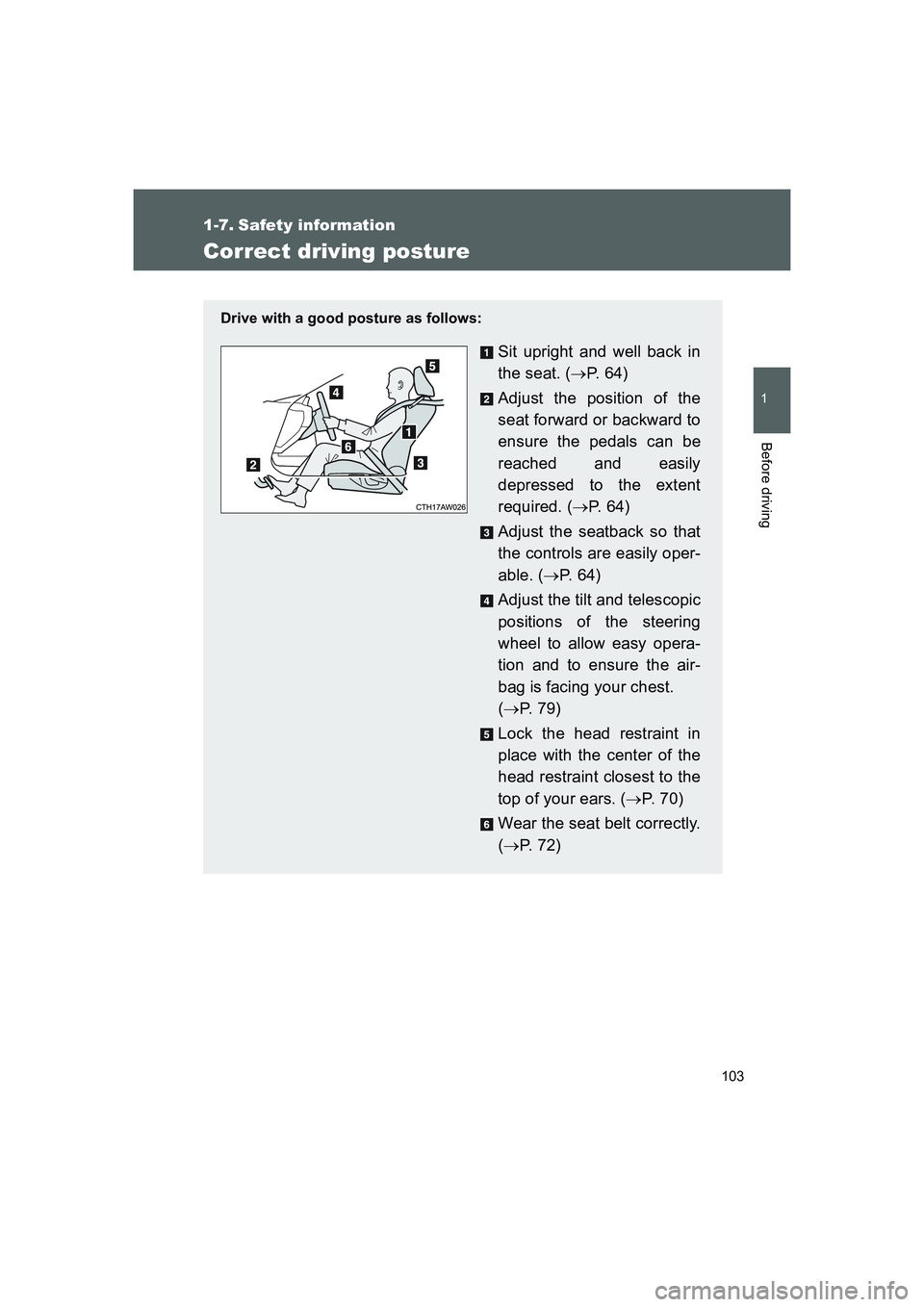
103
1
Before driving
FT86_EE
1-7. Safety information
Correct driving posture
Drive with a good posture as follows:
Sit upright and well back in
the seat. (→P. 6 4 )
Adjust the position of the
seat forward or backward to
ensure the pedals can be
reached and easily
depressed to the extent
required. (→P. 64)
Adjust the seatback so that
the controls are easily oper-
able. (→P. 6 4 )
Adjust the tilt and telescopic
positions of the steering
wheel to allow easy opera-
tion and to ensure the air-
bag is facing your chest.
(→P. 7 9 )
Lock the head restraint in
place with the center of the
head restraint closest to the
top of your ears. (→P. 7 0 )
Wear the seat belt correctly.
(→P. 7 2 )
86_OM_EE_OM18058E.book 103 ページ 2015年3月17日 火曜日 午前11時31分
Page 104 of 464
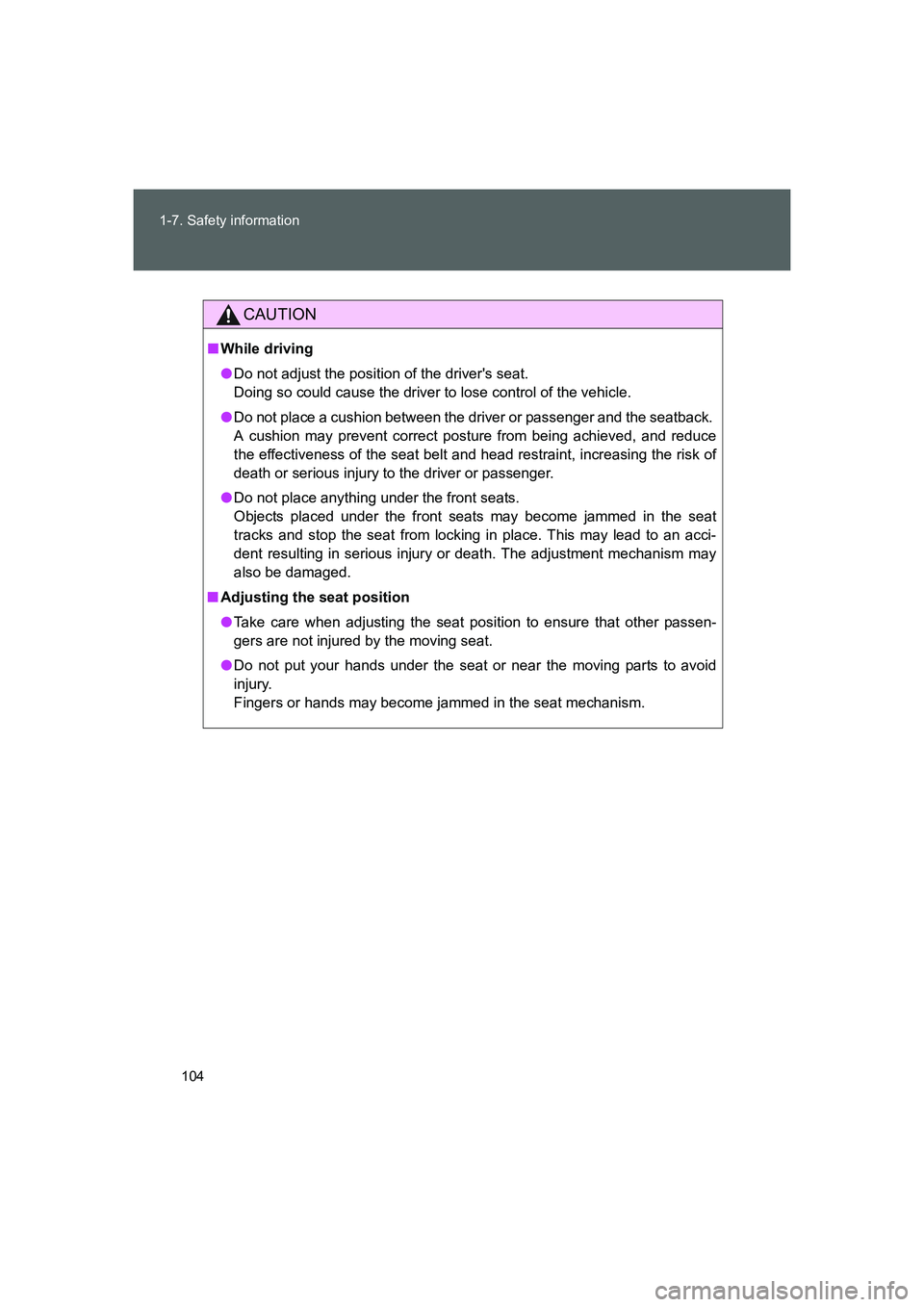
104 1-7. Safety information
FT86_EE
CAUTION
■While driving
●Do not adjust the position of the driver's seat.
Doing so could cause the driver to lose control of the vehicle.
●Do not place a cushion between the driver or passenger and the seatback.
A cushion may prevent correct posture from being achieved, and reduce
the effectiveness of the seat belt and head restraint, increasing the risk of
death or serious injury to the driver or passenger.
●Do not place anything under the front seats.
Objects placed under the front seats may become jammed in the seat
tracks and stop the seat from locking in place. This may lead to an acci-
dent resulting in serious injury or death. The adjustment mechanism may
also be damaged.
■Adjusting the seat position
●Take care when adjusting the seat position to ensure that other passen-
gers are not injured by the moving seat.
●Do not put your hands under the seat or near the moving parts to avoid
injury.
Fingers or hands may become jammed in the seat mechanism.
86_OM_EE_OM18058E.book 104 ページ 2015年3月17日 火曜日 午前11時31分
Page 105 of 464
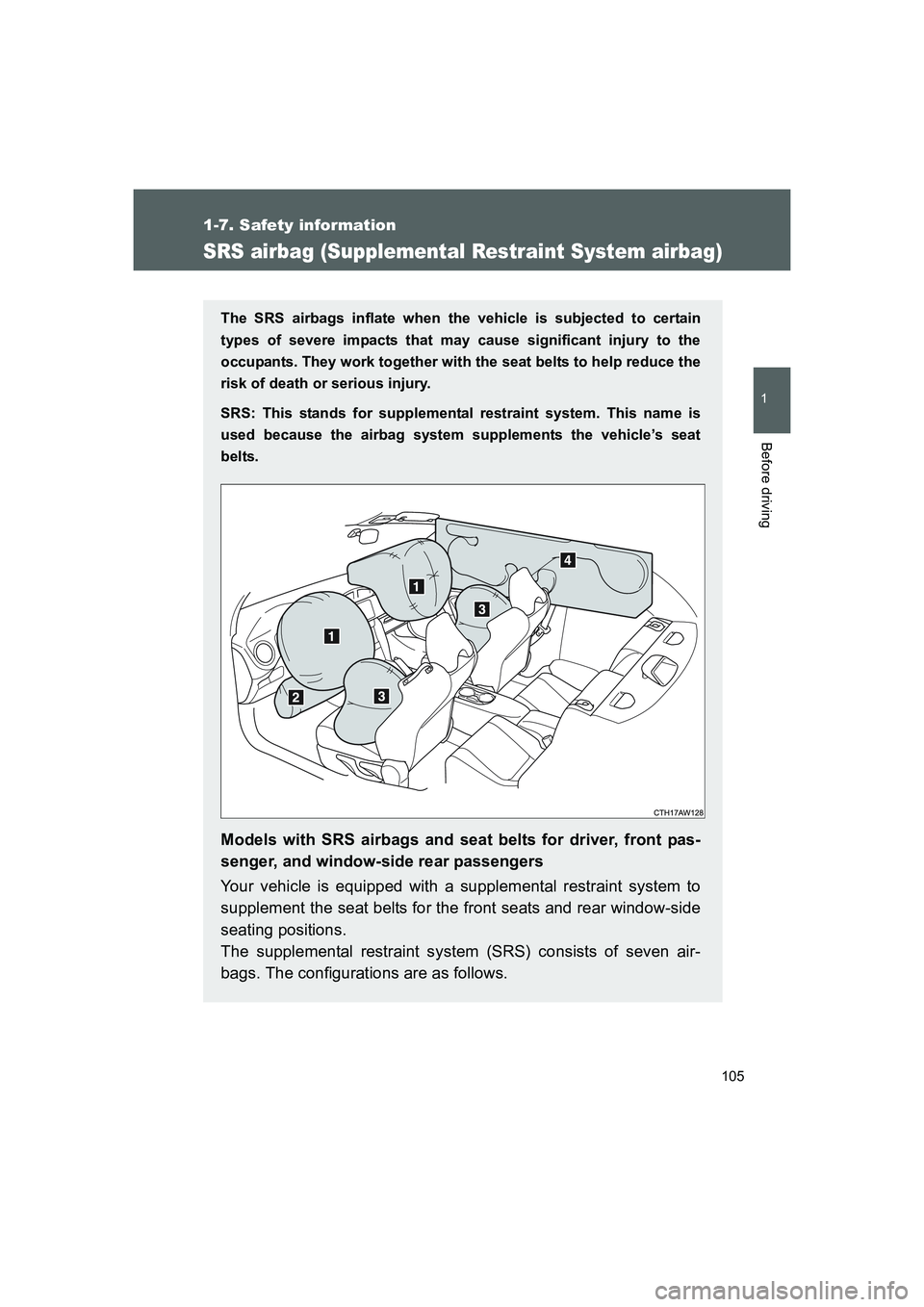
105
1
1-7. Safety information
Before driving
FT86_EE
SRS airbag (Supplemental Restraint System airbag)
The SRS airbags inflate when the vehicle is subjected to certain
types of severe impacts that may cause significant injury to the
occupants. They work together with the seat belts to help reduce the
risk of death or serious injury.
SRS: This stands for supplemental restraint system. This name is
used because the airbag system supplements the vehicle’s seat
belts.
Models with SRS airbags and seat belts for driver, front pas-
senger, and window-side rear passengers
Your vehicle is equipped with a supplemental restraint system to
supplement the seat belts for the front seats and rear window-side
seating positions.
The supplemental restraint system (SRS) consists of seven air-
bags. The configurations are as follows.
86_OM_EE_OM18058E.book 105 ページ 2015年3月17日 火曜日 午前11時31分
Page 106 of 464
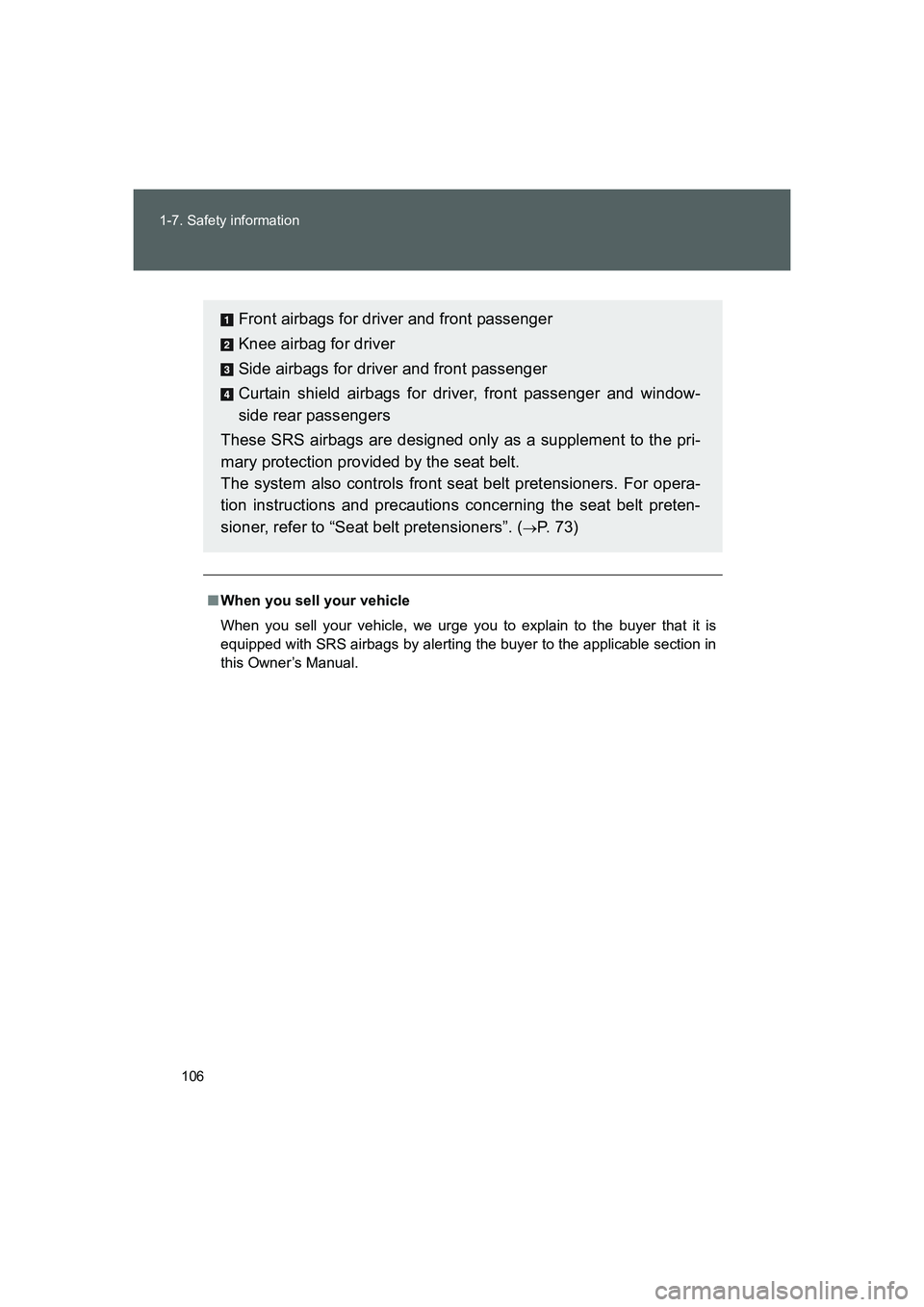
106 1-7. Safety information
FT86_EE
■When you sell your vehicle
When you sell your vehicle, we urge you to explain to the buyer that it is
equipped with SRS airbags by alerting the buyer to the applicable section in
this Owner’s Manual.
Front airbags for driver and front passenger
Knee airbag for driver
Side airbags for driver and front passenger
Curtain shield airbags for driver, front passenger and window-
side rear passengers
These SRS airbags are designed only as a supplement to the pri-
mary protection provided by the seat belt.
The system also controls front seat belt pretensioners. For opera-
tion instructions and precautions concerning the seat belt preten-
sioner, refer to “Seat belt pretensioners”. (
→P. 73)
86_OM_EE_OM18058E.book 106 ページ 2015年3月17日 火曜日 午前11時31分
Page 107 of 464
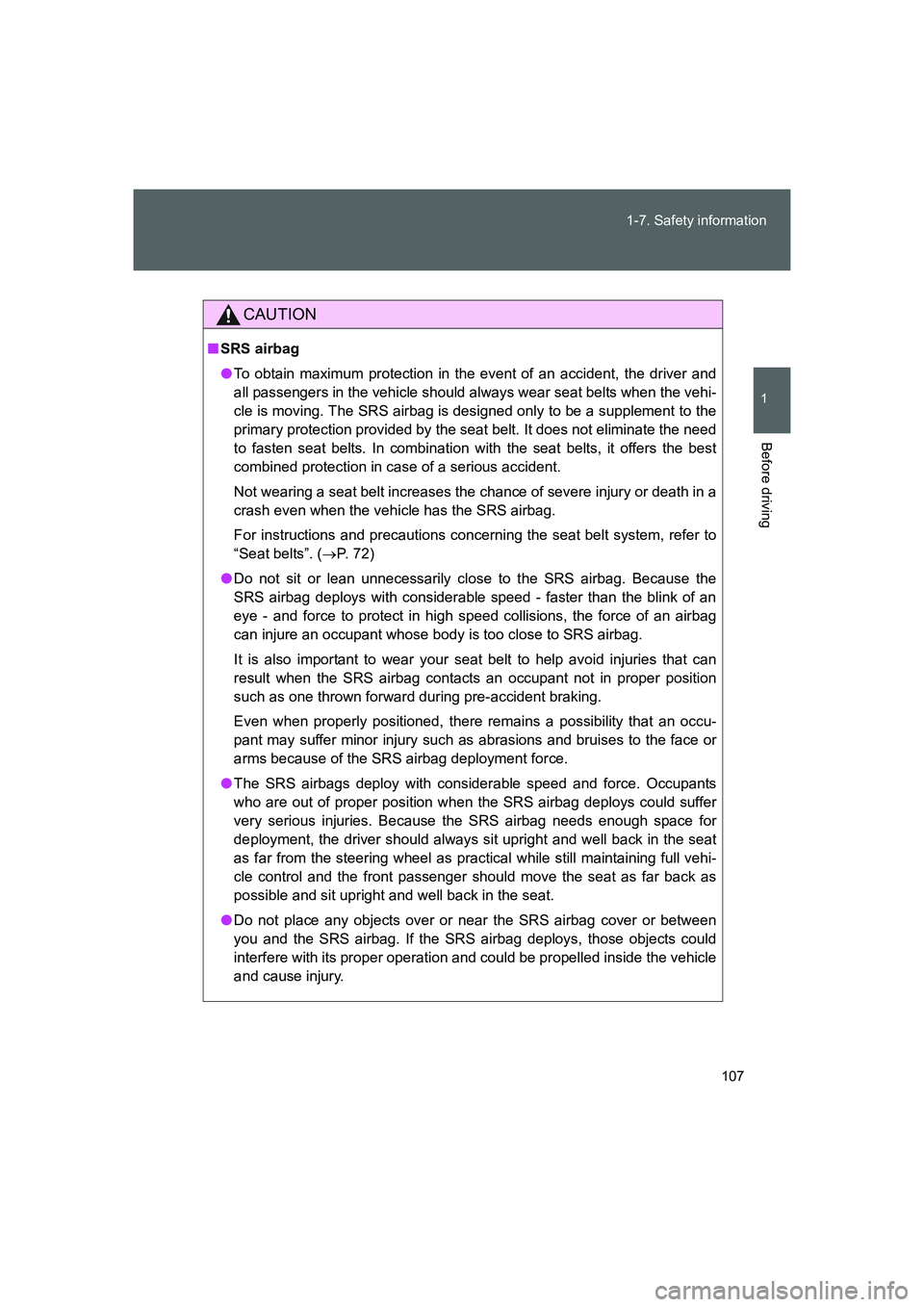
107 1-7. Safety information
1
Before driving
FT86_EE
CAUTION
■SRS airbag
●To obtain maximum protection in the event of an accident, the driver and
all passengers in the vehicle should always wear seat belts when the vehi-
cle is moving. The SRS airbag is designed only to be a supplement to the
primary protection provided by the seat belt. It does not eliminate the need
to fasten seat belts. In combination with the seat belts, it offers the best
combined protection in case of a serious accident.
Not wearing a seat belt increases the chance of severe injury or death in a
crash even when the vehicle has the SRS airbag.
For instructions and precautions concerning the seat belt system, refer to
“Seat belts”. (→P. 72)
●Do not sit or lean unnecessarily close to the SRS airbag. Because the
SRS airbag deploys with considerable speed - faster than the blink of an
eye - and force to protect in high speed collisions, the force of an airbag
can injure an occupant whose body is too close to SRS airbag.
It is also important to wear your seat belt to help avoid injuries that can
result when the SRS airbag contacts an occupant not in proper position
such as one thrown forward during pre-accident braking.
Even when properly positioned, there remains a possibility that an occu-
pant may suffer minor injury such as abrasions and bruises to the face or
arms because of the SRS airbag deployment force.
●The SRS airbags deploy with considerable speed and force. Occupants
who are out of proper position when the SRS airbag deploys could suffer
very serious injuries. Because the SRS airbag needs enough space for
deployment, the driver should always sit upright and well back in the seat
as far from the steering wheel as practical while still maintaining full vehi-
cle control and the front passenger should move the seat as far back as
possible and sit upright and well back in the seat.
●Do not place any objects over or near the SRS airbag cover or between
you and the SRS airbag. If the SRS airbag deploys, those objects could
interfere with its proper operation and could be propelled inside the vehicle
and cause injury.
86_OM_EE_OM18058E.book 107 ページ 2015年3月17日 火曜日 午前11時31分
Page 108 of 464
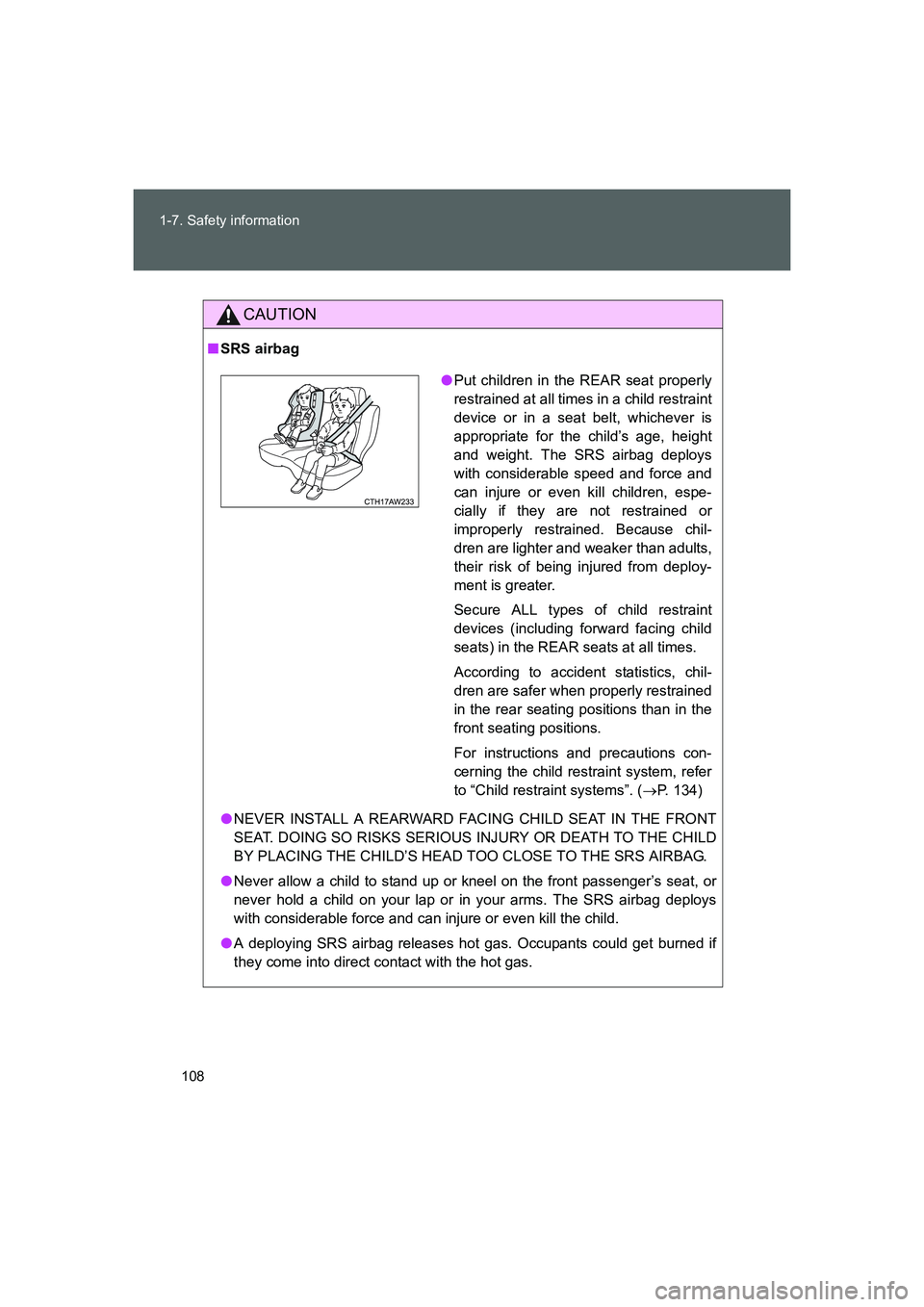
108 1-7. Safety information
FT86_EE
CAUTION
■SRS airbag
●NEVER INSTALL A REARWARD FACING CHILD SEAT IN THE FRONT
SEAT. DOING SO RISKS SERIOUS INJURY OR DEATH TO THE CHILD
BY PLACING THE CHILD’S HEAD TOO CLOSE TO THE SRS AIRBAG.
●Never allow a child to stand up or kneel on the front passenger’s seat, or
never hold a child on your lap or in your arms. The SRS airbag deploys
with considerable force and can injure or even kill the child.
●A deploying SRS airbag releases hot gas. Occupants could get burned if
they come into direct contact with the hot gas.
●Put children in the REAR seat properly
restrained at all times in a child restraint
device or in a seat belt, whichever is
appropriate for the child’s age, height
and weight. The SRS airbag deploys
with considerable speed and force and
can injure or even kill children, espe-
cially if they are not restrained or
improperly restrained. Because chil-
dren are lighter and weaker than adults,
their risk of being injured from deploy-
ment is greater.
Secure ALL types of child restraint
devices (including forward facing child
seats) in the REAR seats at all times.
According to accident statistics, chil-
dren are safer when properly restrained
in the rear seating positions than in the
front seating positions.
For instructions and precautions con-
cerning the child restraint system, refer
to “Child restraint systems”. (→P. 134)
86_OM_EE_OM18058E.book 108 ページ 2015年3月17日 火曜日 午前11時31分
Page 109 of 464
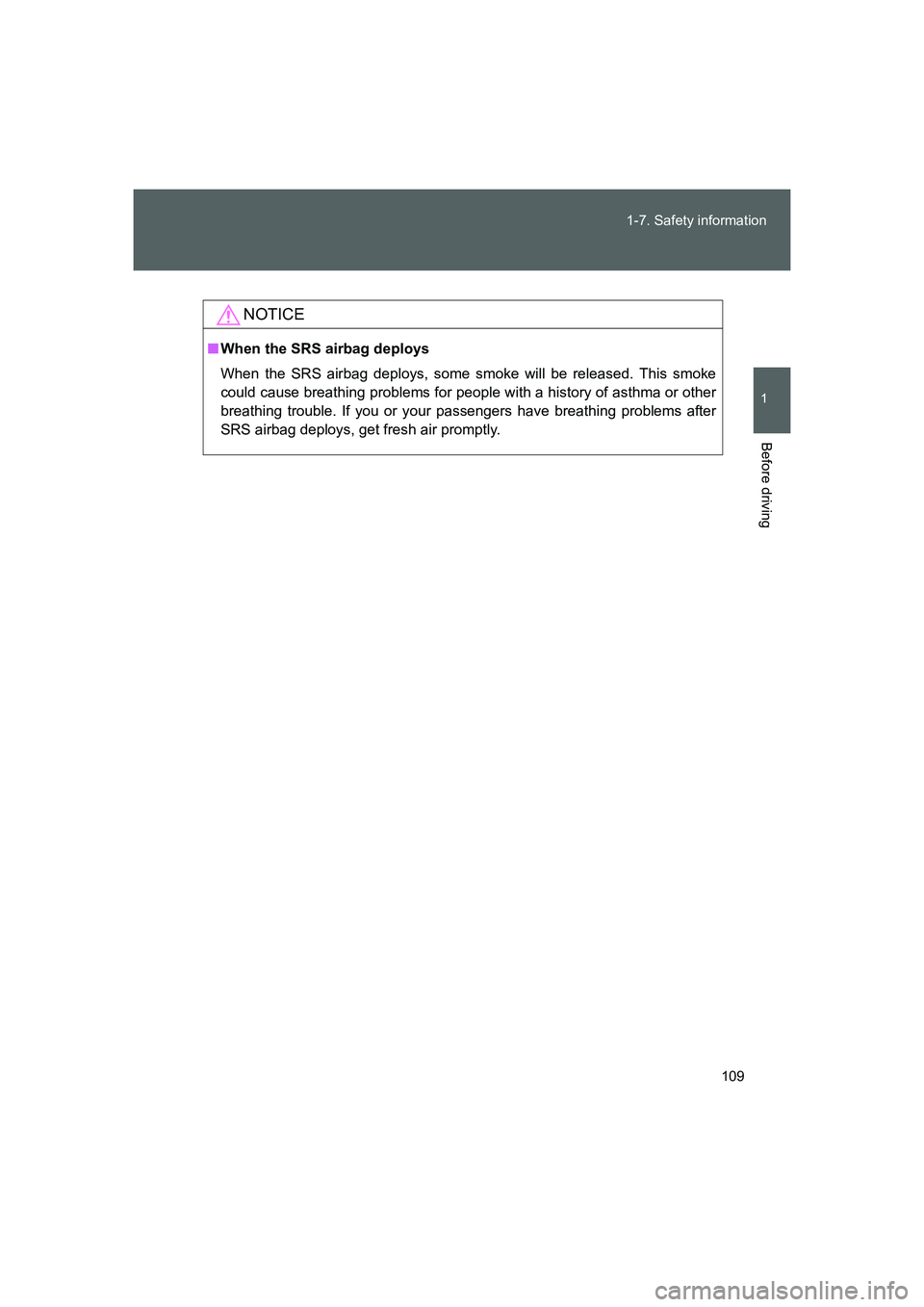
109 1-7. Safety information
1
Before driving
FT86_EE
NOTICE
■When the SRS airbag deploys
When the SRS airbag deploys, some smoke will be released. This smoke
could cause breathing problems for people with a history of asthma or other
breathing trouble. If you or your passengers have breathing problems after
SRS airbag deploys, get fresh air promptly.
86_OM_EE_OM18058E.book 109 ページ 2015年3月17日 火曜日 午前11時31分
Page 110 of 464
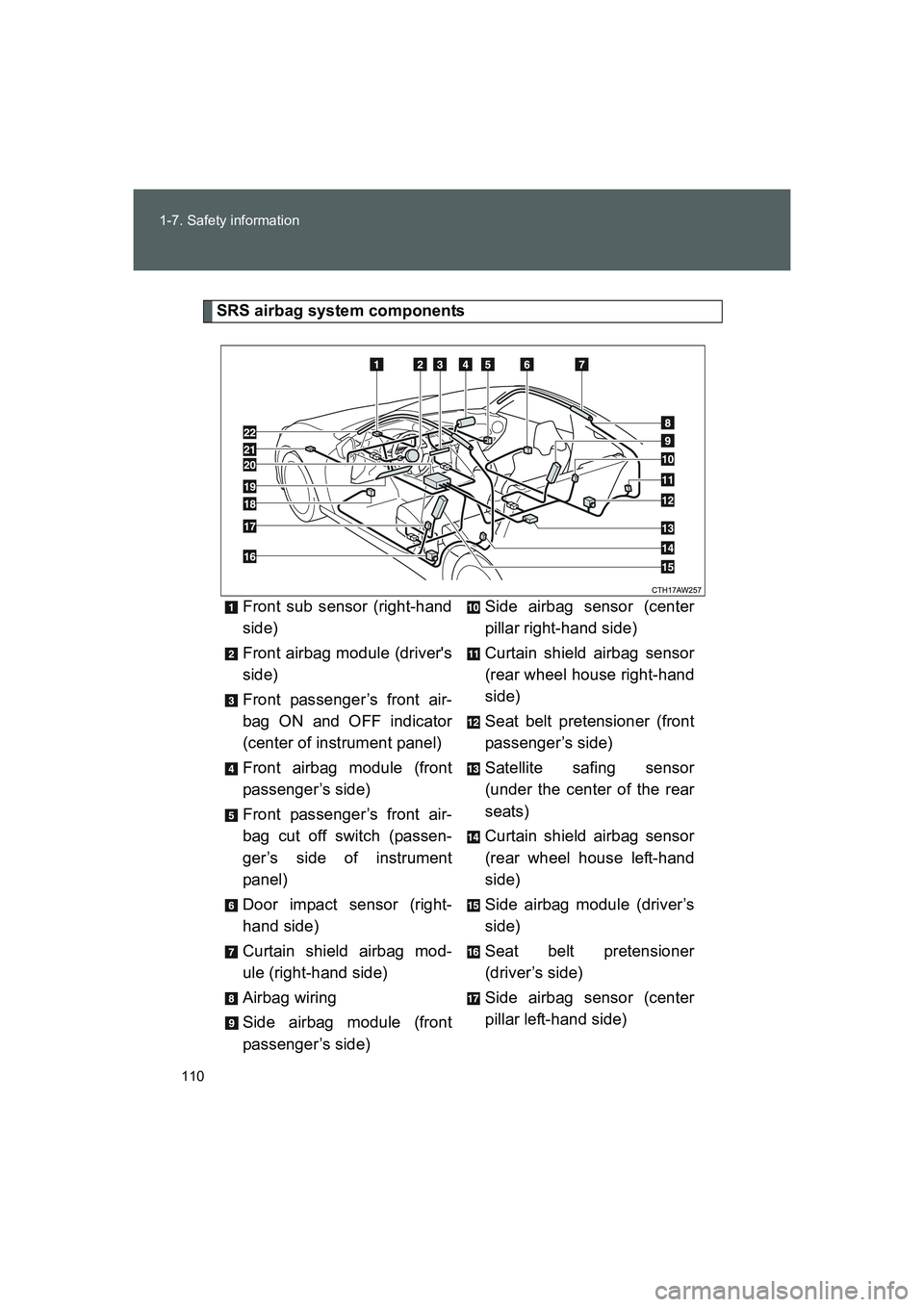
110 1-7. Safety information
FT86_EE
SRS airbag system components
Front sub sensor (right-hand
side)
Front airbag module (driver's
side)
Front passenger’s front air-
bag ON and OFF indicator
(center of instrument panel)
Front airbag module (front
passenger’s side)
Front passenger’s front air-
bag cut off switch (passen-
ger’s side of instrument
panel)
Door impact sensor (right-
hand side)
Curtain shield airbag mod-
ule (right-hand side)
Airbag wiring
Side airbag module (front
passenger’s side)Side airbag sensor (center
pillar right-hand side)
Curtain shield airbag sensor
(rear wheel house right-hand
side)
Seat belt pretensioner (front
passenger’s side)
Satellite safing sensor
(under the center of the rear
seats)
Curtain shield airbag sensor
(rear wheel house left-hand
side)
Side airbag module (driver’s
side)
Seat belt pretensioner
(driver’s side)
Side airbag sensor (center
pillar left-hand side)
86_OM_EE_OM18058E.book 110 ページ 2015年3月17日 火曜日 午前11時31分